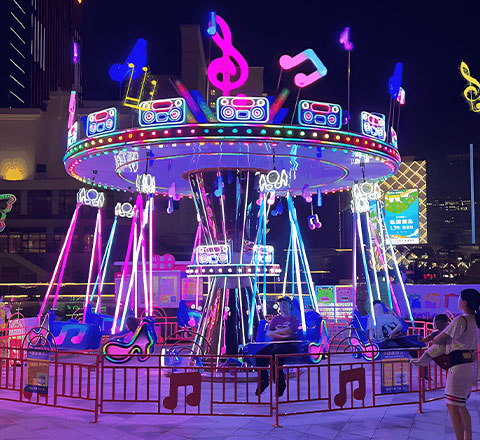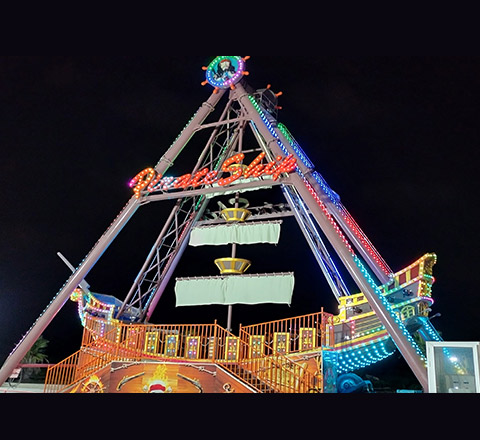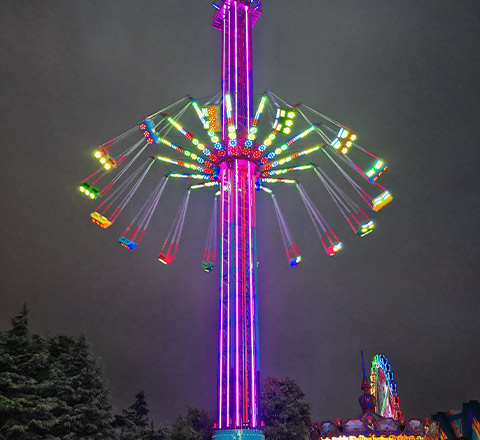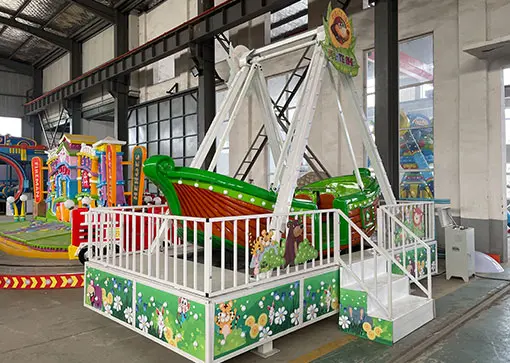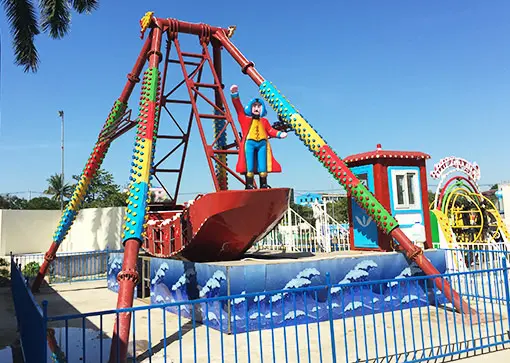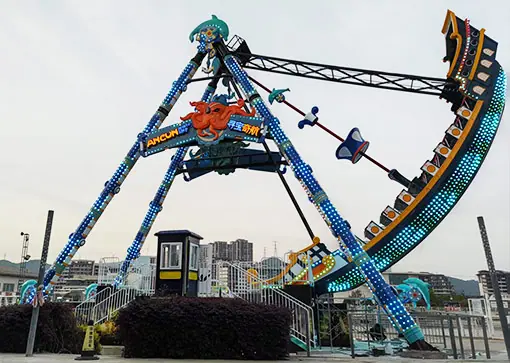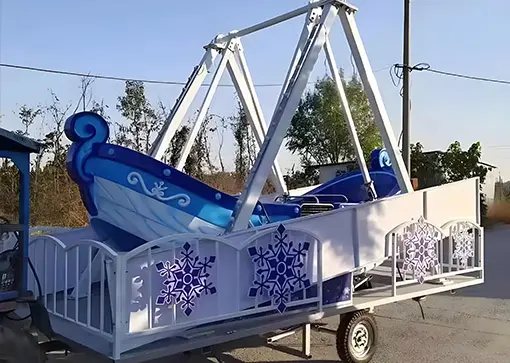For operators and investors, the pirate ship ride (also called a Viking ship ride or swinging ship) remains a proven anchor attraction: strong curb appeal, wide age coverage, efficient throughput, and predictable lifecycle cost. This comprehensive FAQ consolidates years of manufacturing, installation, and operating experience to help you choose, purchase, and run the most suitable pirate ship ride for your venue.
1) What exactly is a pirate ship ride (a.k.a. Viking Ship Ride or swinging ship ride)?
A pirate ship ride is a pendulum-type amusement ride in which a boat-shaped gondola swings back and forth around a horizontal axle. An electric drive initiates motion, while gravity sustains oscillation. The result is a rhythmic increase in amplitude that delivers a floating or “airtime” sensation on each pass—family-friendly at modest angles and genuinely thrilling at higher angles.
2) Which Size or Capacity of Pirate Ship Ride Should I Choose?
Match site constraints, guest profile, and target throughput. Use the table below as a starting framework; values are indicative and customizable.
Typical Specification Ranges (Reference Only)
| Seats | Peak Swing Angle | Footprint (L × W) | Overall Height | Drive Power (approx.) | Best-Fit Venues |
| 10 (mini) | 35–45° | 5 × 3 m | 3.8–4.5 m | 2–4 kW | Indoor FECs, malls, small family zones |
| 16–18 | 45–60° | 12–15 × 6–7 m | 7–9 m | 6–10 kW | Mobile fairs, city parks |
| 24 | 60–75° | 16–18 × 8–9 m | 9–11 m | 12–18 kW | Community parks, mixed-audience areas |
| 32 | 75–90° | 20–22 × 10–11 m | 11–13 m | 18–25 kW | Regional/theme parks |
| 40 | up to 90° | 26 × 8.5–12 m | 13–15 m | 25–35 kW | Flagship zones, high-throughput hubs |
Selection tip: For family-oriented areas, modest angles and capacities boost comfort and re-ride intent. For teen/thrill precincts, larger pirate ship ride and angles add drama, sightlines, and social buzz.
3) How much does a pirate ship amusement ride cost?
The price of the pirate ship carnival ride depends on seat count, structural size, swing angle, FRP craftsmanship, control and safety systems, décor/theming, and export/installation scope. For a deep dive with examples, see How Much Does a Pirate Ship Ride Cost?.
Cost Drivers (Typical Contribution)
| Cost Component | Typical Share |
| Steel structure & fabrication | 30–40% |
| FRP hull/seats & paint system | 15–25% |
| Electrical/drive/controls (PLC, VFD, sensors) | 15–20% |
| Theming & lighting (RGB, figurehead, trims) | 10–15% |
| Logistics & export documents | 5–10% |
| Installation, commissioning & training | 5–10% |

4) What certifications and standards should I look for?
Confirm pirate ship ride factory licenses, quality management, and ride-safety conformity for your market. Ask for type-test and load-test reports, material traceability, weld NDT records, FAT/SAT protocols, and complete operating documentation. Electrical compliance (voltage/frequency/grounding) must match national codes.
5) Are pirate ship rides safe? Which features matter most?
When engineered and maintained properly, pirate ship amusement park rides are inherently safe. Prioritize:
- Dual/redundant braking systems (friction/hydraulic), tested at full load
- Restraints: lap bars or shoulder presses with interlocks and belt backups
- Overspeed/over-angle protection, E-stop circuits, soft-start/soft-stop logic
- Robust load paths, certified bearings/fasteners, anti-loosening systems
For programmatic policies and operator rules, consult Safety Measures of Pirate Ship Rides.
6) What site conditions and foundations are required?
- A clear swing envelope plus guest buffer zones and queue ingress/egress
- Reinforced concrete foundations with anchor bolts per issued drawings
- Drainage, cable ducts, earthing/grounding within specified resistance
- Crane access for erection, and protected routes for heavy components\
7) What power and voltage do I need?
Typical configurations require three-phase power (e.g., 380–415 V/50 Hz or 208–240 V/60 Hz). Confirm main breaker size, cable gauge, and inrush current during acceleration. As a rule of thumb, 32–40-seat models draw ~18–35 kW at peak.
8) How long are production, shipping, and installation?
- Production: roughly 2–5 weeks depending on model and theming
- Shipping: sea freight by container or flat-rack, 2–6+ weeks by region
- Installation & commissioning: 5–10 days with a trained crew
Carnee Rides, one of China’s leading pirate ship ride manufacturers, provides complete installation manuals and training videos, with optional on-site engineer assistance to guarantee smooth installation and safe operation. For detailed guidance, see Operation Tips for Pirate Ship Ride.
9) What is daily operation like (cycle time and throughput)?
A typical ride cycle lasts 2–3.5 minutes; including loading/unloading, many parks achieve 4–8 dispatches per hour depending on staffing, restraint type, and guest flow.
Throughput (illustrative):
32 seats × 8 cycles/hour × 85% load factor ≈ ~218 riders/hour.
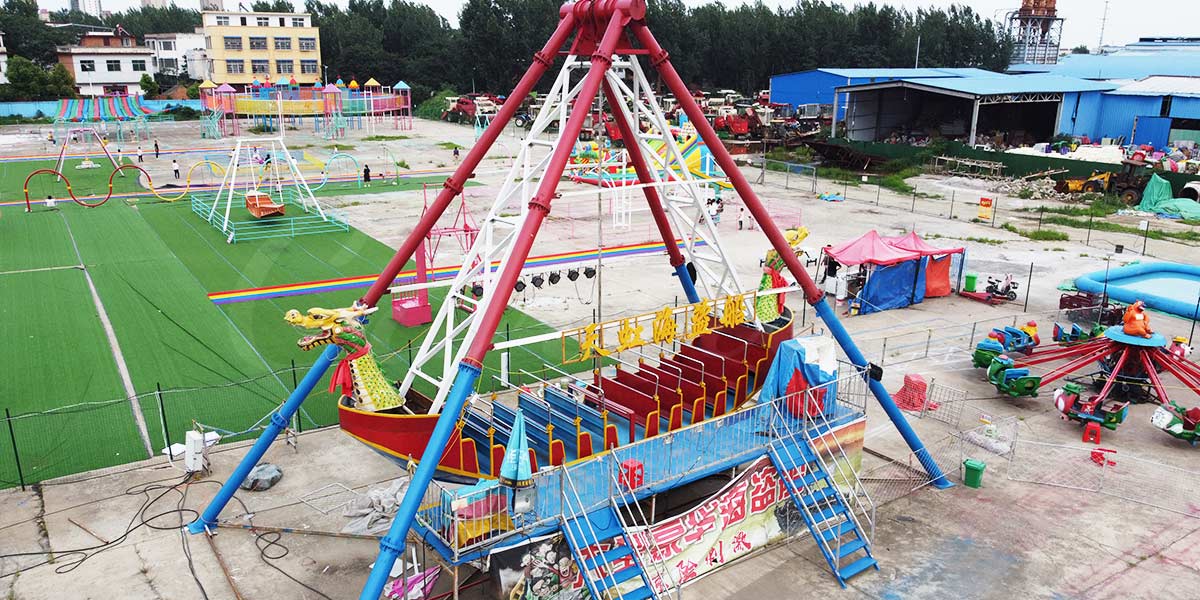
10) What are the real operating costs?
- Electricity: size-dependent (see Spec Table). Model your tariff per kWh and expected utilization.
- Staffing: most sites use one operator + one attendant for safe dispatch cadence.
- Routine maintenance: lubrication, inspections, and scheduled replacements.
- Compliance & insurance: periodic inspections as required by local regulations.
Create a cost-per-hour baseline to inform ticketing and promotions.
11) How do I estimate ROI and payback?
Use a simple model:
Monthly Revenue = Ticket Price × Avg. Load Factor × Seats × Daily Operating Hours × Operating Days
Monthly Gross Margin = Monthly Revenue – (Power + Labor + Maintenance + Insurance + Depreciation/Finance)
Under realistic assumptions, many installations reach payback in 6–18 months (market-dependent).
12) What maintenance schedule should I follow?
- Daily: visual checks, fastener/seat/restraint and brake inspections, functional tests, cleaning
- Monthly: lubricate bearings and pivots; verify sensors and interlocks
- Annually: full audit, consumable replacements, corrosion checks, paint touch-ups
Maintain service logs and work orders for audits, warranty, and trend analysis. (For more information, learn: How to Maintain a Pirate Ship Amusement Ride: Complete Guide )
13) Which spare parts should be stocked?
Keep a first-line spares kit: bearings, brake pads/fluid, drive rollers, limit switches/sensors, relay/PLC I/O modules, LED drivers, fastener packs, seals, and approved greases. Set target lead times for critical parts.
14) Can I customise the theme, colours, lighting, and branding?
Yes. Options include figurehead design, hull colours, RGB show lighting, rail and seat trims, soundtrack and audio prompts, and logo branding. Electrical voltage and plug standards can be matched to national infrastructure.
15) How do weather, corrosion, and lightning affect the ride?
Outdoor amusement rides benefit from hot-dip galvanising or multi-coat anti-corrosion systems, protected cable routing, and IP-rated enclosures. In coastal/high-humidity areas, specify thicker coatings, stainless hardware where sensible, and scheduled wash-downs. For lightning, use bonding/equipotential, surge protection, and—where appropriate—ESE systems.
16) What documentation will I receive?
- General arrangement drawings, foundation/anchor plans, and electrical schematics
- Installation, operation, and maintenance manuals
- Material certificates, weld/NDT records, load/acceptance test reports
- Export documentation, packing lists, and warranty terms
17) How are shipping and packaging handled?
Major structures of the pirate ship rides are protected against abrasion; FRP parts are film-wrapped and crated, sensitive electronics are vibration-protected, and crates bear clear unboxing marks. Trade terms (FOB/CIF/DDP) are available with door-to-door and customs support on request.
18) What warranty and after-sales support are included?
Typical warranties cover 12 months for manufacturing defects (consumables excluded) plus lifetime technical support. Expect remote diagnostics, operator training, periodic inspections, and long-term spare-parts supply.
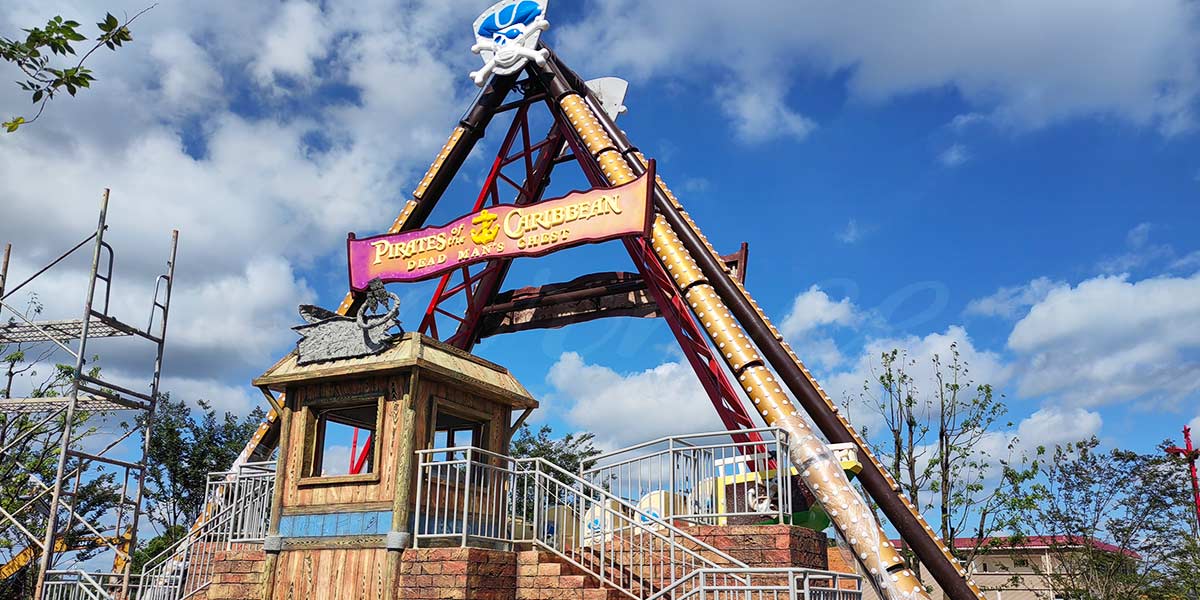
19) What rider restrictions and safety rules apply?
Publish and enforce:
- Minimum height thresholds suitable for the model and local code (often ~110–120 cm)
- Medical advisories (cardiovascular conditions, pregnancy, post-operative recovery)
- Loose-article and baggage restrictions; must use restraints as instructed
- No cross-over into the swing envelope; use E-stop and evacuate if anomalies occur
20) How do I compare manufacturers fairly?
Pirate Ship Amusement Ride Manufacturer Evaluation Checklist
- Licensing & compliance: production permits, third-party inspections, factory acceptance tests
- Fabrication quality: steel grade, weld procedures + NDT, FRP thickness and UV-resistant paint systems
- Electrical & controls: branded components, PLC/VFD architecture, protection, and interlock logic
- Installation & training: completeness of drawings/manuals, on-site capability
- After-sales: documented SLA, spare parts pricing and lead times
- References: in-operation case studies, repeat buyers, verifiable testimonials
- Contract clarity: warranty boundaries, extended-warranty options, payment & Incoterms
For model comparisons and availability, visit our pirate ship rides for sale page.
FAQ — Concise Answers to Common Queries
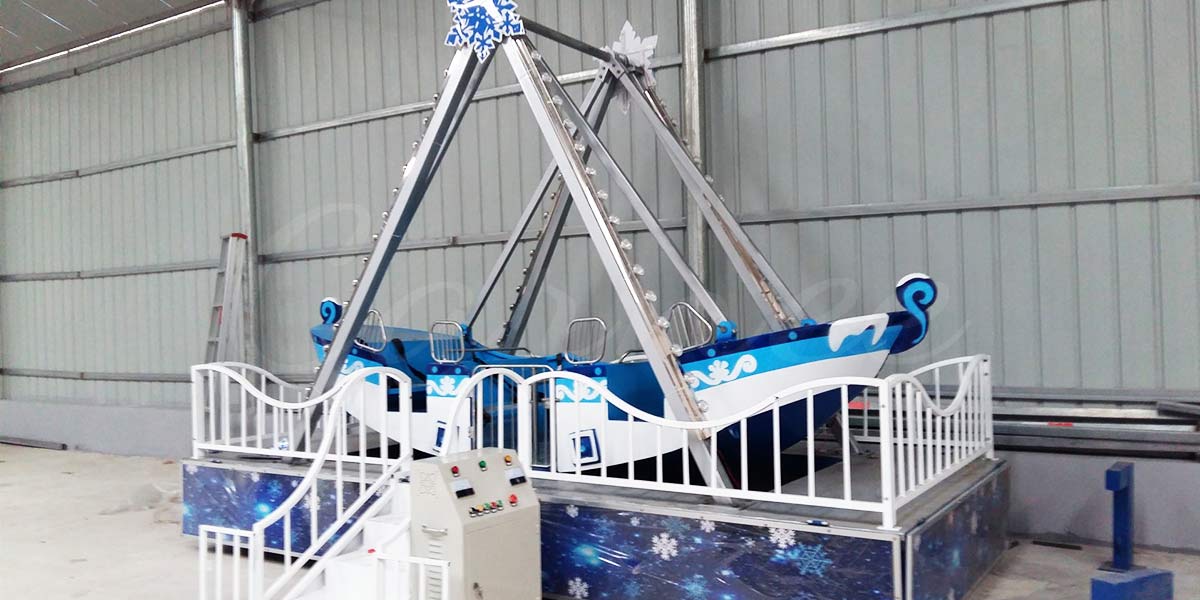
Model Matching Cheat Sheet
| Scenario | Recommended Model | Rationale |
| Indoor FEC / mall | 8–16 seats, small angle | Minimal footprint and noise; family-friendly motion |
| City/community park | 24 seats, mid angle | Balanced throughput and power draw |
| Theme-park flagship | 32–40 seats, large angle | Iconic skyline presence; strong social/visual pull |
| Seasonal carnival / touring | 16–24 seats, quick-install | Faster erection/tear-down; transport-friendly |
Pre-Purchase Checklist (Print-Friendly)
- ✅ Finalize capacity, swing angle, and footprint against crowd and throughput targets
- ✅ Verify electrical service, foundations, lifting access, and site logistics
- ✅ Review materials/welds, braking/interlocks, and load/acceptance tests
- ✅ Confirm production, shipping, installation windows, and trade terms
- ✅ Obtain full drawings, O&M manuals, and spare-parts/consumables list
- ✅ Define warranty boundaries, SLA, and a preventive maintenance plan
About Carnee Rides
With 20+ years of amusement park design and manufacturing experience, Carnee Rides provides end-to-end delivery—from concept and theming to fabrication, export, installation, training, and long-term maintenance. Our goal is simple: predictable throughput, reliable safety, and compelling guest experiences.
You may also like: Top 10 Iconic Amusement Park Rides



